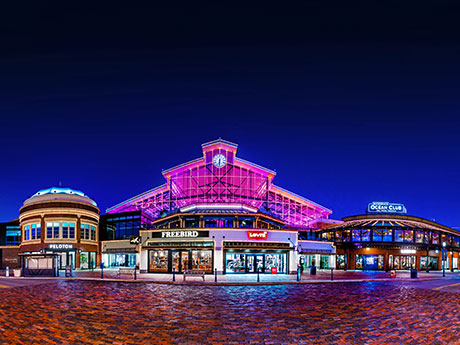By Spencer Jordan, Steiner + Associates
The retail environment in Columbus, Ohio, is not just among the most unique and diverse in the Midwest, but in the nation. Columbus currently enjoys the fourth highest concentration of retail headquarters of any American city. Familiar names like Bath & Body Works, Victoria’s Secret, Express, Big Lots! and Chipotle all call Columbus home, and brands like Lululemon have significant logistics and distribution infrastructure in the city.
But why is Columbus such a popular retail hub? What is the state of Columbus retail today? What sectors and neighborhoods are performing, and what are the trends to monitor when it comes to the future of retail in the Columbus market?

Why Columbus?
Among the many factors driving Columbus’s sustained retail success, the most important piece of the puzzle is the big picture: the city is thriving — and not just economically. Columbus placed eighth nationally in WalletHub’s recent rankings of all 50 state capitals, coming in ahead of popular high-profile markets like Denver, Nashville and Boston. The rankings are based on affordability, economic well being, quality of health and education, and quality of life.
Columbus is one of the strongest Midwest markets in GDP per capita and the state of Ohio is the seventh largest economy in the nation. Columbus stands out for the diversity of its economic drivers. Industries ranging from automotive, fashion and life sciences to semi-conductor manufacturing all play an important role. But it isn’t just strong economic fundamentals that have made Columbus an extremely popular Midwestern test market.
Columbus is a diverse city with a very large student population and a demographic profile that makes it, in many respects, a microcosm of the national population. With a remarkable 52 colleges and universities and approximately 160,000 students living in and around the city, Columbus is a kind of Midwest melting pot. Iconic brands like Honda, Google and Intel continue to hire in and around Columbus, further bolstering a diverse, youthful and well-educated workforce.
As a representative market in a state that has traditionally been a swing state, the city is viewed by many retailers as a kind of national barometer. When you consider the fact that Columbus is just a day’s drive away from 60 percent of the total U.S. population, it’s not hard to see why retailers view the city favorably as a great place to plant their flags for new concepts and expansion possibilities.
Retail dynamics
No discussion about Columbus retail is complete without noting the impact and influence of Easton Town Center. The iconic mixed-use project continues to generate exceptional sales-per-square-foot numbers that place it among the most profitable retail destinations in the country — and Easton was voted the top retail experience in America in both 2021 and 2022. A true super regional destination, Easton’s trade area spans 100 miles north/south and 50 miles east/west, and several of Easton’s retail tenants occupy the brands’ only Midwest retail locations outside of Chicago.
While Easton is the dominant super-regional property, Polaris Towne Center on the north side of town is well leased and serves the fast-growing Delaware County populace. In the Columbus suburb of Dublin, Bridge Park is a relatively new development, but has done well introducing more mixed-use elements to the northwest side of the city — especially dining and entertainment.
In downtown Columbus, the Short North Arts District has evolved to become a signature dining and nightlife destination and is home to over 300 businesses. Pockets of discovery offer creative and experiential retail concepts and a long-and-growing list of unique food options in places like Grandview Yard, German Village, Clintonville and the Short North.
Some specific retail sectors have seen significant growth recently, perhaps most notably the luxury segment. At Easton, a first-to-market Louis Vuitton recently completed a substantial remerchandising effort and will be opening a newly expanded and redesigned space, and market newcomers David Yurman, Golden Goose, BOSS and Breitling are all new additions to the project’s Fashion District.
Growing momentum
The good news for Columbus retailers is that momentum is showing no signs of slowing. To the contrary, with tech giant Intel committing to a new Columbus hub of two separate semiconductor fabrication factories on a 1,000-acre site just outside the city, Columbus’s economic and demographic trend lines continue to point upward. Intel alone will be adding a projected 3,000 jobs with an average salary of around $130,000. If just half of that $390 million annual income is spent on goods and services locally, the economic growth potential for area retailers is significant.
Columbus also continues to densify. A recent study found that, along with Austin, Texas, Columbus experienced “the largest population growth among major U.S. metropolitan areas during the last half of 2023.” That continuing influx of educated, relatively affluent employees and residents can be seen in a booming housing market. Columbus came in at No. 3 overall in Zillow’s 2024 rankings forecasting the top 10 hottest housing markets of 2024. That represents a jump of 17 spots from 2023. Zillow also predicts that Columbus “will have the highest percentage of new owner-occupied homes compared to any other major metro in 2024.”
With its economic diversity, strong demographic profile, booming population and a diverse and dynamic civic environment, it would not be surprising to see Columbus maintain its status as one of the nation’s most successful and fast-growing retail environments for the foreseeable future.
Spencer Jordan is senior vice president of leasing with Steiner + Associates. This article originally appeared in the April 2024 issue of Heartland Real Estate Business magazine.


